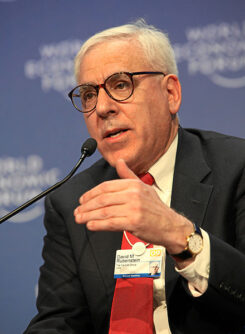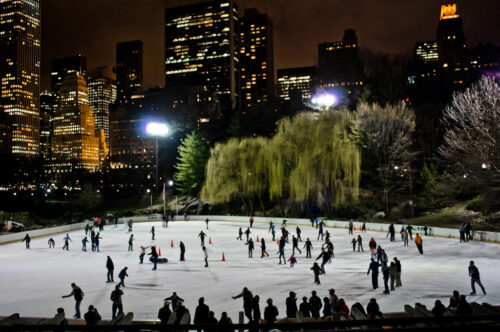Progressive critiques of private philanthropy ignore prior public experience with government spending.
Businessman, investor, and philanthropist David Rubenstein—who’s “passionate about U.S. history,” according to The Washington Post—announced in late October that he was donating $10 million to upgrade and add exhibit space to the Jefferson Memorial in Washington, D.C. This is just the latest in a series of Rubenstein grants to rehabilitate ailing historical memorials around the nation’s capital, including the Lincoln Memorial, the Marine Corps War Memorial, and the Washington Monument.

As might be expected in an atmosphere suddenly bristling with hostility toward such gestures, the gift was immediately denounced by Anand Giridharadas, Twitterverse denizen and author of Winners Take All: The Elite Charade of Changing the World. Rubenstein “fought to keep the carried-interest loophole,” Giridharadas tweeted, and “without it, plutocrats would pay $18 billion more in taxes a year. Which is enough to fund 40 such repairs each year. For each president.” Progressive presidential candidates are getting in on the action as well. Bernie Sanders tweeted, “Say Bill Gates was actually taxed $100 billion. We could end homelessness and provide safe drinking water to everyone in this country.”
Well, yes—in theory. But in the case of Giridhiradas, it’s hardly fair to calculate how many such projects could ideally be funded by tax dollars, and compare this vast bounty to one actual measly gift funded by private dollars. The real world doesn’t work this way.
That world is better captured by a response tweeted by ardent Donald Trump supporter Wojciech Pawelczyk. It contained a news clip featuring CBS reporter Bob Schieffer, reporting from Manhattan on the reopening of Central Park’s Wollman Rink. The ice rink, once a civic jewel, had closed in 1980 for essential and overdue repairs. After more than half a decade and $12 million, the rink finally reopened in 1986—but no thanks to City Hall. Indeed, the city had finally admitted that it had completely failed. It had then reluctantly accepted “flamboyant real estate tycoon” Trump’s offer to do the job himself.

According to his account in The Art of the Deal, Trump made the offer because he had gotten tired of gazing down from his Trump Tower apartment at “the mess the city had made” of the Wollman Rink. He finished the project “under budget and in three and a half months,” Schieffer observes. “The debacle illustrates what can happen at all levels of government when red tape and bidding regulations designed to protect taxpayers sometimes works against them,” he concludes.
In this case, the low bidder had proposed to install some 23 miles of copper tubing through which freon would flow in order to create the ice. In The Art of the Deal, Trump recounts the series of mishaps following this decision. It’s a sort of municipal version of the movie Mr. Blandings Builds His Dream House. In the real-life, ice-rink version, the pouring of the concrete punctures the copper tubing, the leaks in the copper tubing undermine the concrete, and one repair after another succeed only in destroying previous repairs. The project had finally ground to a halt, with the city concluding that it had to go back to the drawing board.
Once Trump took over with a saline-based system and speedily succeeded where the city had failed, he assumed management of the newly reopened rink. As decades of visitors to Central Park can attest, he also slapped his name on it in huge letters (now, by the way, being removed). “The rink which had been a perpetual money loser started making money immediately,” according to a report in Forbes, “which Trump donated to charity.”
It should be noted that, had a soft-spoken foundation president or an appealing, socially conscious corporate CEO initiated this project rather than an obnoxiously “flamboyant real estate tycoon,” this would be touted in the philanthropic literature today as a leading example of the power of public-private partnerships. The city had gotten an expedited and cost-effective public good from private enterprise, with charity reaping rewards as well.
But, in fact, Trump had to fight New York City’s bureaucracy and Mayor Ed Koch tooth and nail to finish the project for them. Indeed, they only turned it over to him after the city’s media had made it too embarrassing to continue declining his offer. The public officials involved clearly were counting on Trump to fail as humiliatingly as they had. So, no social-enterprise awards for this guy.
Twisted pipes and broken concrete
Giridhiradas’ response to Rubenstein’s gift to repair the monument—we could fix a lot more if we just took his money and spent it ourselves!—ignores the disheartening tale of the Wollman Rink and what it represents: this is how most Americans have experienced most government projects. They sound so good in the abstract, but invariably become mired in “red tape and bidding regulations.” Even with the best of intentions, they so often wind up creating, after substantial delays and at considerable expense, a vast expanse of twisted pipes and broken concrete where an iconic ice skating rink once stood.
A central problem with progressives’ critiques of private philanthropy is that they neglect this prior public experience with government spending. For taxpayers and voters possessing reasonable memories, the alternatives don’t present themselves as isolated and idiosyncratic philanthropic spending versus reliable, high-quality, equitable public spending. Voters frequently benefit from—and are grateful for—the former. Given enough economic growth and encouragement to channel some of it into philanthropy, they can count on more of it in the future.
But over many decades now, as voters can attest, the latter alternative—efficient and equitable public spending—has not been so evident in the real world, though thriving in glowing political-campaign promises and beautifully woven progressive utopias.
It’s no accident that Trump referred frequently to his Wollman Rink experience in his campaign for president. It suggested to millions of (strategically located) voters that he had managed to create something good in the face of a bloated, inert, resistant public bureaucracy, which had done everything it could to avoid, embarrass, and obstruct him. There seemed to be some hope that he might be able to do the same to hostile, arrogant governing elites on a national scale.
Irwin Kula and Craig Hatkoff’s Forbes piece, written 15 months before Trump won the presidency, suggests that however the election turned out, the narrative of the Wollman Rink might reshape American politics. “[Trump] is shaking up the dysfunctional political system in an almost unimaginable manner in an unfathomable time frame. He has done in a few months what many would think would take years if not generations. Kind of like Wollman Rink.” The title of the Forbes article: “Donald Trump and the Wollman Rinking of American Politics.”
Posing the practice of private against the ideal of public spending
Now for the disclaimers mandatory in the age of Trump: I’m not suggesting that the President’s version of the Wollman episode is entirely accurate. David Freedlander’s treatment in Bloomberg—again, tellingly entitled “A 1980s New York City Battle Explains Donald Trump’s Candidacy”—quotes plenty of critics of Trump’s narrative. Their message boils down to, “Ahh, anybody could have done it.” Well, perhaps. But they didn’t. Instead, Trump’s version of events proved so compelling at the time that even mainstream media outlets like CBS ran with it. This was an era, as Schieffer put it, when the Pentagon was buying thousand-dollar coffee pots—that is, when bureaucratic incompetence was newsworthy, and didn’t detract from today’s preferred media narrative of “Orange Man Bad.”
I’m also not defending Trump’s political or philanthropic activities. Nor am I suggesting we could have expected that what worked for Wollman would work for Washington. As President Barack Obama discovered after a promise of major infrastructure improvements and the futile expenditure of millions of tax dollars, there are in fact very few “shovel-ready” projects comparable to skating rinks.
Finally, I’m not arguing that we should substitute private philanthropy for public spending, or even that private philanthropy is always superior. Of course, we need both. But if we wish to make sound judgments about the public utility of each, it won’t do to pose the practice of private gifts—which can be artfully cast as merely self-serving and idiosyncratic—against the ideal of public spending—which too easily becomes, “We can just take that money and get lots more of exactly what we want!”
The American people have learned from bitter experience that it doesn’t work that way. They’re probably correct to assume that if philanthropists like David Rubenstein weren’t around to help fix our monuments—that is, if we had to rely on government spending alone—many fewer would be fixed, and much less well.



